Effective Communication Skills Diagnosis and Reflection Report
VerifiedAdded on 2020/05/16
|16
|4330
|287
Report
AI Summary
This report examines effective communication skills, focusing on diagnostic tools and various communication styles such as mediators, analyzers, socializers, and aggressor-asserters. It discusses the communication process, including planning, message formulation, channel selection, and active listening. The report identifies key communication issues, such as formulating clear messages and improving listening skills, and provides a literature review on active listening and effective communication models. The author reflects on personal communication challenges and offers strategies for improvement, highlighting the importance of non-verbal cues, open-mindedness, and asking clarifying questions. The report emphasizes the significance of effective communication in both personal and professional settings, offering practical insights and models for enhancing communication abilities.
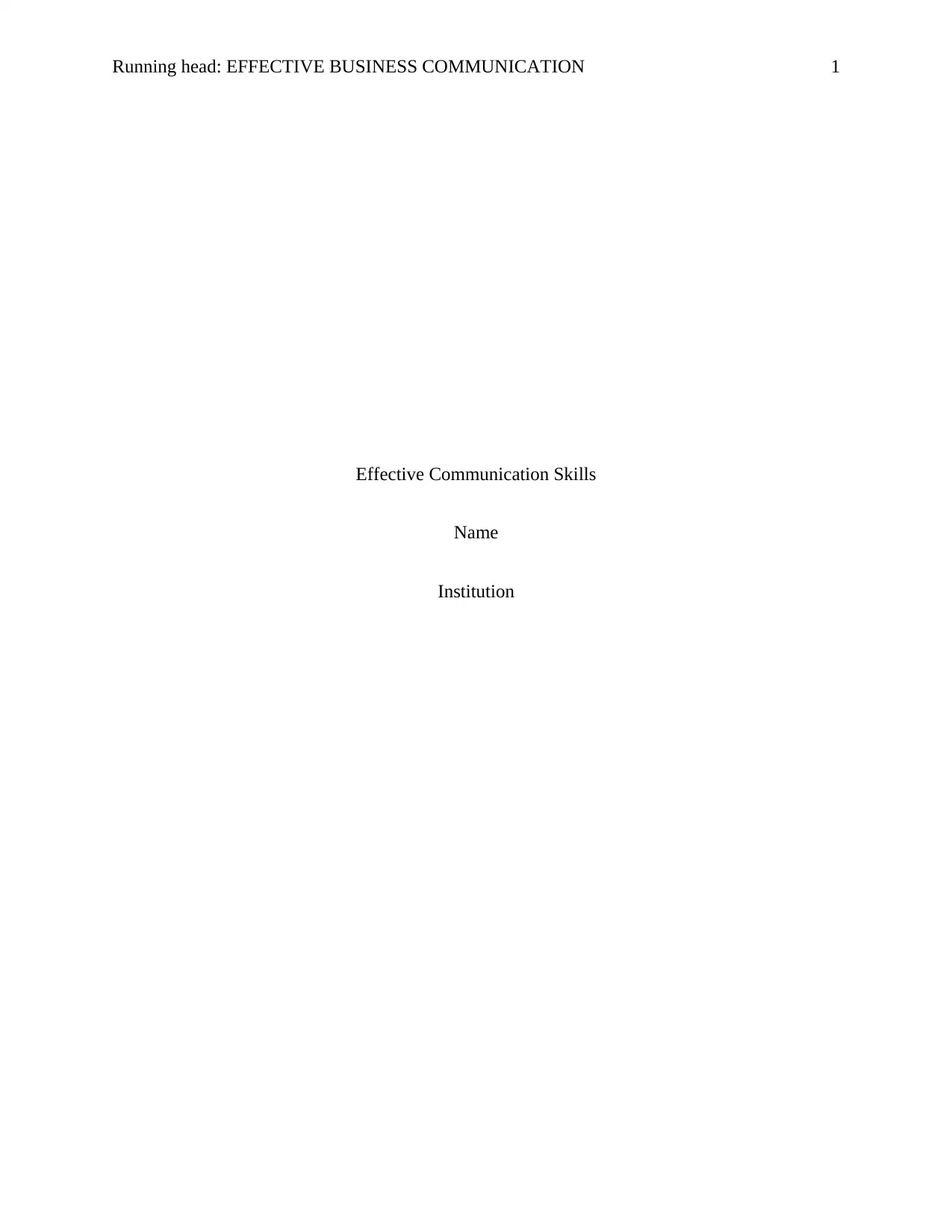
Running head: EFFECTIVE BUSINESS COMMUNICATION 1
Effective Communication Skills
Name
Institution
Effective Communication Skills
Name
Institution
Secure Best Marks with AI Grader
Need help grading? Try our AI Grader for instant feedback on your assignments.
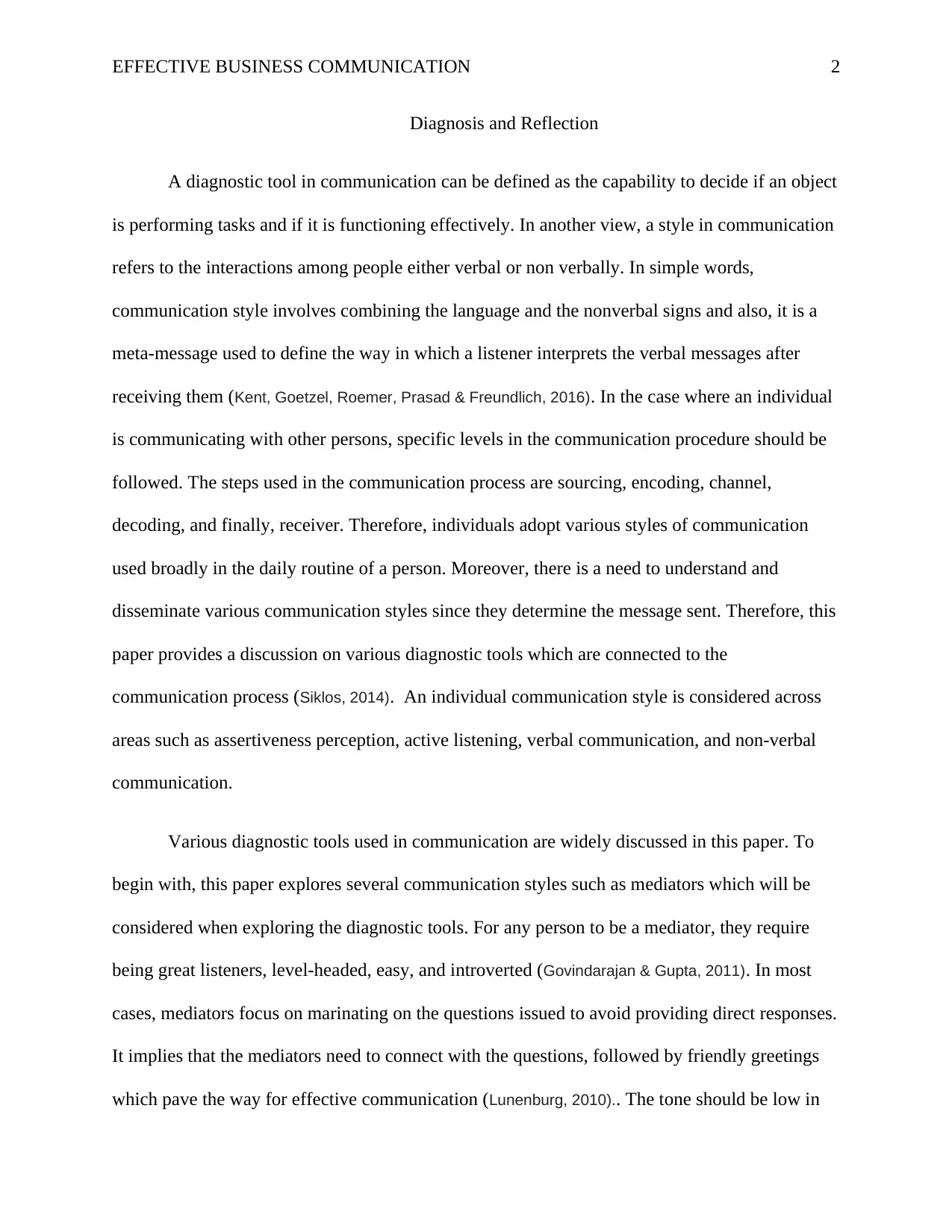
EFFECTIVE BUSINESS COMMUNICATION 2
Diagnosis and Reflection
A diagnostic tool in communication can be defined as the capability to decide if an object
is performing tasks and if it is functioning effectively. In another view, a style in communication
refers to the interactions among people either verbal or non verbally. In simple words,
communication style involves combining the language and the nonverbal signs and also, it is a
meta-message used to define the way in which a listener interprets the verbal messages after
receiving them (Kent, Goetzel, Roemer, Prasad & Freundlich, 2016). In the case where an individual
is communicating with other persons, specific levels in the communication procedure should be
followed. The steps used in the communication process are sourcing, encoding, channel,
decoding, and finally, receiver. Therefore, individuals adopt various styles of communication
used broadly in the daily routine of a person. Moreover, there is a need to understand and
disseminate various communication styles since they determine the message sent. Therefore, this
paper provides a discussion on various diagnostic tools which are connected to the
communication process (Siklos, 2014). An individual communication style is considered across
areas such as assertiveness perception, active listening, verbal communication, and non-verbal
communication.
Various diagnostic tools used in communication are widely discussed in this paper. To
begin with, this paper explores several communication styles such as mediators which will be
considered when exploring the diagnostic tools. For any person to be a mediator, they require
being great listeners, level-headed, easy, and introverted (Govindarajan & Gupta, 2011). In most
cases, mediators focus on marinating on the questions issued to avoid providing direct responses.
It implies that the mediators need to connect with the questions, followed by friendly greetings
which pave the way for effective communication (Lunenburg, 2010).. The tone should be low in
Diagnosis and Reflection
A diagnostic tool in communication can be defined as the capability to decide if an object
is performing tasks and if it is functioning effectively. In another view, a style in communication
refers to the interactions among people either verbal or non verbally. In simple words,
communication style involves combining the language and the nonverbal signs and also, it is a
meta-message used to define the way in which a listener interprets the verbal messages after
receiving them (Kent, Goetzel, Roemer, Prasad & Freundlich, 2016). In the case where an individual
is communicating with other persons, specific levels in the communication procedure should be
followed. The steps used in the communication process are sourcing, encoding, channel,
decoding, and finally, receiver. Therefore, individuals adopt various styles of communication
used broadly in the daily routine of a person. Moreover, there is a need to understand and
disseminate various communication styles since they determine the message sent. Therefore, this
paper provides a discussion on various diagnostic tools which are connected to the
communication process (Siklos, 2014). An individual communication style is considered across
areas such as assertiveness perception, active listening, verbal communication, and non-verbal
communication.
Various diagnostic tools used in communication are widely discussed in this paper. To
begin with, this paper explores several communication styles such as mediators which will be
considered when exploring the diagnostic tools. For any person to be a mediator, they require
being great listeners, level-headed, easy, and introverted (Govindarajan & Gupta, 2011). In most
cases, mediators focus on marinating on the questions issued to avoid providing direct responses.
It implies that the mediators need to connect with the questions, followed by friendly greetings
which pave the way for effective communication (Lunenburg, 2010).. The tone should be low in
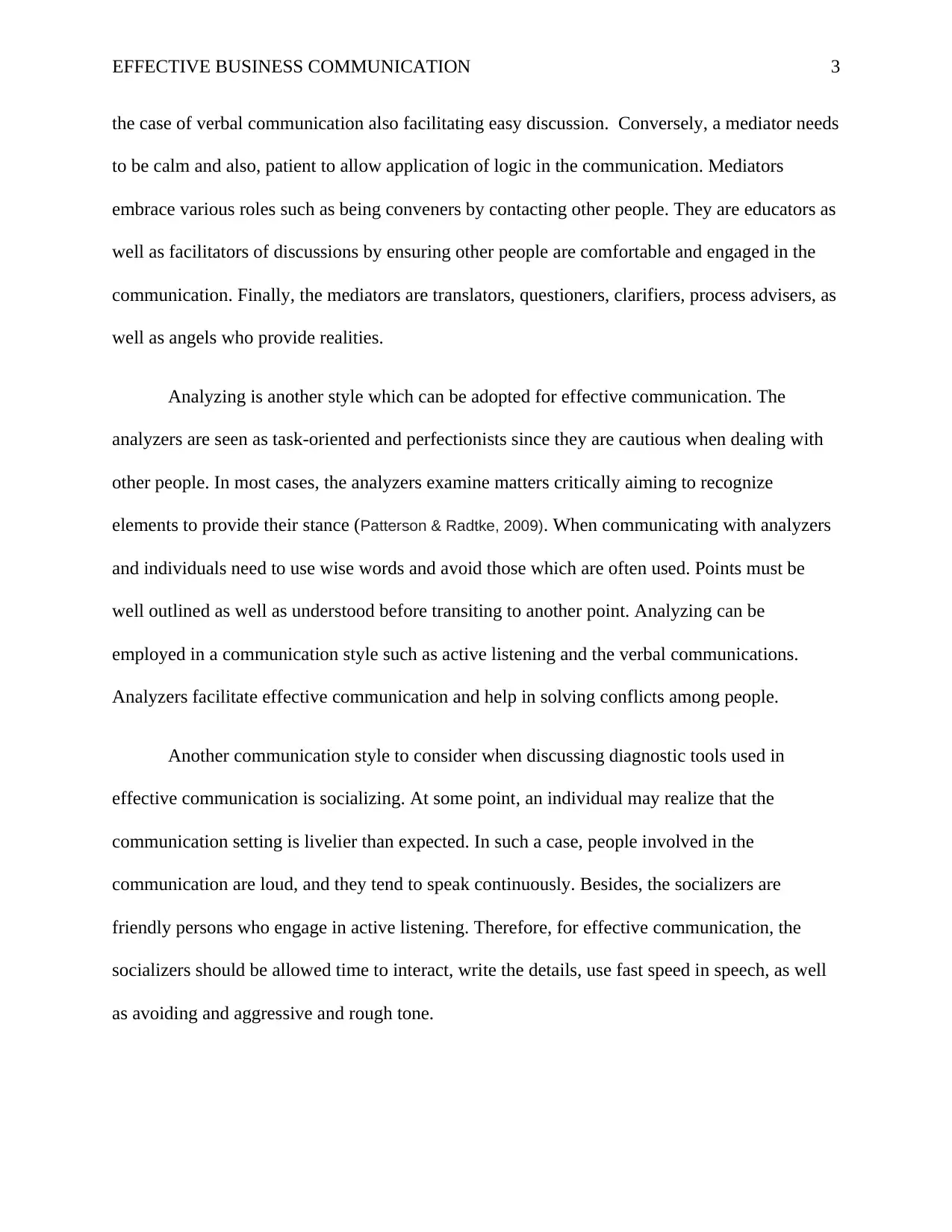
EFFECTIVE BUSINESS COMMUNICATION 3
the case of verbal communication also facilitating easy discussion. Conversely, a mediator needs
to be calm and also, patient to allow application of logic in the communication. Mediators
embrace various roles such as being conveners by contacting other people. They are educators as
well as facilitators of discussions by ensuring other people are comfortable and engaged in the
communication. Finally, the mediators are translators, questioners, clarifiers, process advisers, as
well as angels who provide realities.
Analyzing is another style which can be adopted for effective communication. The
analyzers are seen as task-oriented and perfectionists since they are cautious when dealing with
other people. In most cases, the analyzers examine matters critically aiming to recognize
elements to provide their stance (Patterson & Radtke, 2009). When communicating with analyzers
and individuals need to use wise words and avoid those which are often used. Points must be
well outlined as well as understood before transiting to another point. Analyzing can be
employed in a communication style such as active listening and the verbal communications.
Analyzers facilitate effective communication and help in solving conflicts among people.
Another communication style to consider when discussing diagnostic tools used in
effective communication is socializing. At some point, an individual may realize that the
communication setting is livelier than expected. In such a case, people involved in the
communication are loud, and they tend to speak continuously. Besides, the socializers are
friendly persons who engage in active listening. Therefore, for effective communication, the
socializers should be allowed time to interact, write the details, use fast speed in speech, as well
as avoiding and aggressive and rough tone.
the case of verbal communication also facilitating easy discussion. Conversely, a mediator needs
to be calm and also, patient to allow application of logic in the communication. Mediators
embrace various roles such as being conveners by contacting other people. They are educators as
well as facilitators of discussions by ensuring other people are comfortable and engaged in the
communication. Finally, the mediators are translators, questioners, clarifiers, process advisers, as
well as angels who provide realities.
Analyzing is another style which can be adopted for effective communication. The
analyzers are seen as task-oriented and perfectionists since they are cautious when dealing with
other people. In most cases, the analyzers examine matters critically aiming to recognize
elements to provide their stance (Patterson & Radtke, 2009). When communicating with analyzers
and individuals need to use wise words and avoid those which are often used. Points must be
well outlined as well as understood before transiting to another point. Analyzing can be
employed in a communication style such as active listening and the verbal communications.
Analyzers facilitate effective communication and help in solving conflicts among people.
Another communication style to consider when discussing diagnostic tools used in
effective communication is socializing. At some point, an individual may realize that the
communication setting is livelier than expected. In such a case, people involved in the
communication are loud, and they tend to speak continuously. Besides, the socializers are
friendly persons who engage in active listening. Therefore, for effective communication, the
socializers should be allowed time to interact, write the details, use fast speed in speech, as well
as avoiding and aggressive and rough tone.
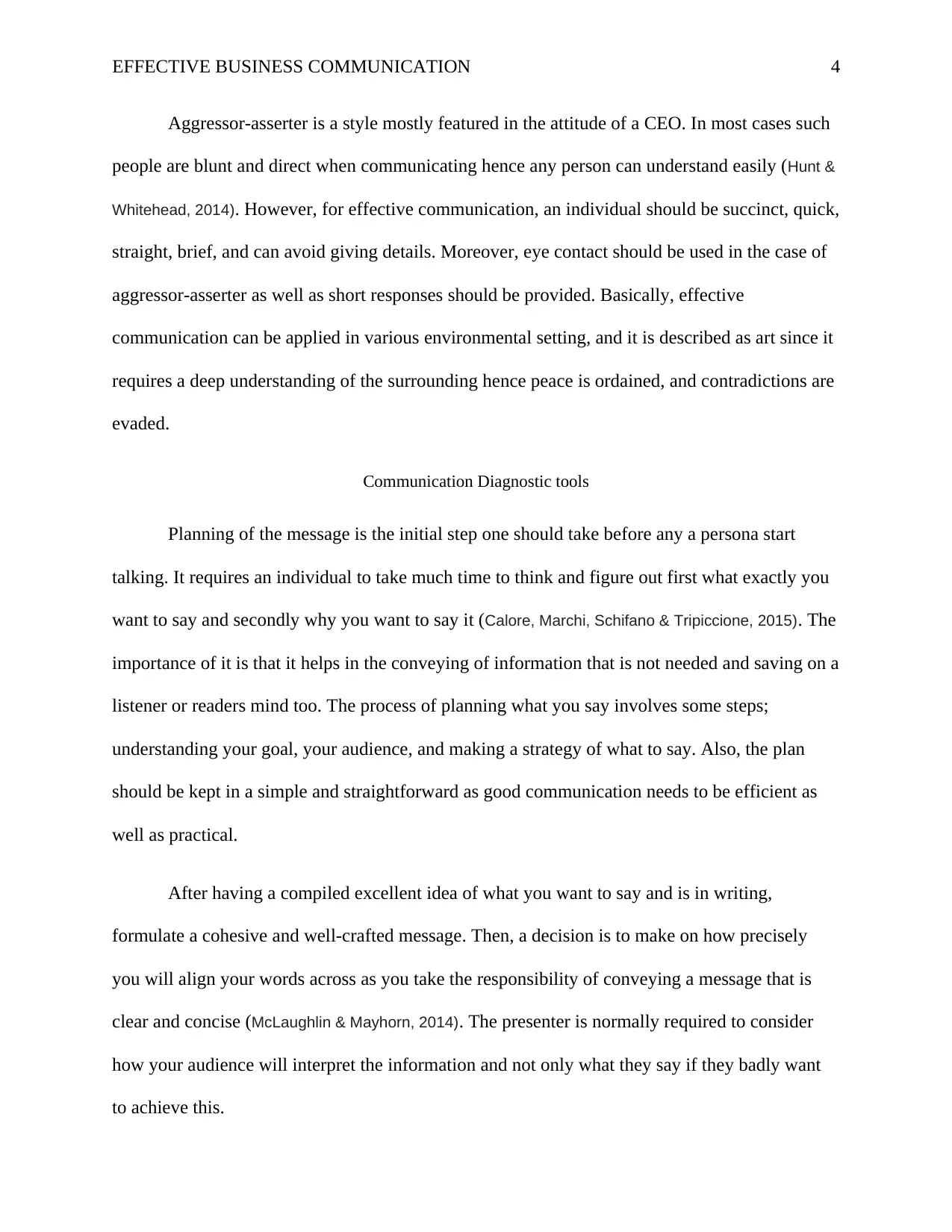
EFFECTIVE BUSINESS COMMUNICATION 4
Aggressor-asserter is a style mostly featured in the attitude of a CEO. In most cases such
people are blunt and direct when communicating hence any person can understand easily (Hunt &
Whitehead, 2014). However, for effective communication, an individual should be succinct, quick,
straight, brief, and can avoid giving details. Moreover, eye contact should be used in the case of
aggressor-asserter as well as short responses should be provided. Basically, effective
communication can be applied in various environmental setting, and it is described as art since it
requires a deep understanding of the surrounding hence peace is ordained, and contradictions are
evaded.
Communication Diagnostic tools
Planning of the message is the initial step one should take before any a persona start
talking. It requires an individual to take much time to think and figure out first what exactly you
want to say and secondly why you want to say it (Calore, Marchi, Schifano & Tripiccione, 2015). The
importance of it is that it helps in the conveying of information that is not needed and saving on a
listener or readers mind too. The process of planning what you say involves some steps;
understanding your goal, your audience, and making a strategy of what to say. Also, the plan
should be kept in a simple and straightforward as good communication needs to be efficient as
well as practical.
After having a compiled excellent idea of what you want to say and is in writing,
formulate a cohesive and well-crafted message. Then, a decision is to make on how precisely
you will align your words across as you take the responsibility of conveying a message that is
clear and concise (McLaughlin & Mayhorn, 2014). The presenter is normally required to consider
how your audience will interpret the information and not only what they say if they badly want
to achieve this.
Aggressor-asserter is a style mostly featured in the attitude of a CEO. In most cases such
people are blunt and direct when communicating hence any person can understand easily (Hunt &
Whitehead, 2014). However, for effective communication, an individual should be succinct, quick,
straight, brief, and can avoid giving details. Moreover, eye contact should be used in the case of
aggressor-asserter as well as short responses should be provided. Basically, effective
communication can be applied in various environmental setting, and it is described as art since it
requires a deep understanding of the surrounding hence peace is ordained, and contradictions are
evaded.
Communication Diagnostic tools
Planning of the message is the initial step one should take before any a persona start
talking. It requires an individual to take much time to think and figure out first what exactly you
want to say and secondly why you want to say it (Calore, Marchi, Schifano & Tripiccione, 2015). The
importance of it is that it helps in the conveying of information that is not needed and saving on a
listener or readers mind too. The process of planning what you say involves some steps;
understanding your goal, your audience, and making a strategy of what to say. Also, the plan
should be kept in a simple and straightforward as good communication needs to be efficient as
well as practical.
After having a compiled excellent idea of what you want to say and is in writing,
formulate a cohesive and well-crafted message. Then, a decision is to make on how precisely
you will align your words across as you take the responsibility of conveying a message that is
clear and concise (McLaughlin & Mayhorn, 2014). The presenter is normally required to consider
how your audience will interpret the information and not only what they say if they badly want
to achieve this.
Secure Best Marks with AI Grader
Need help grading? Try our AI Grader for instant feedback on your assignments.
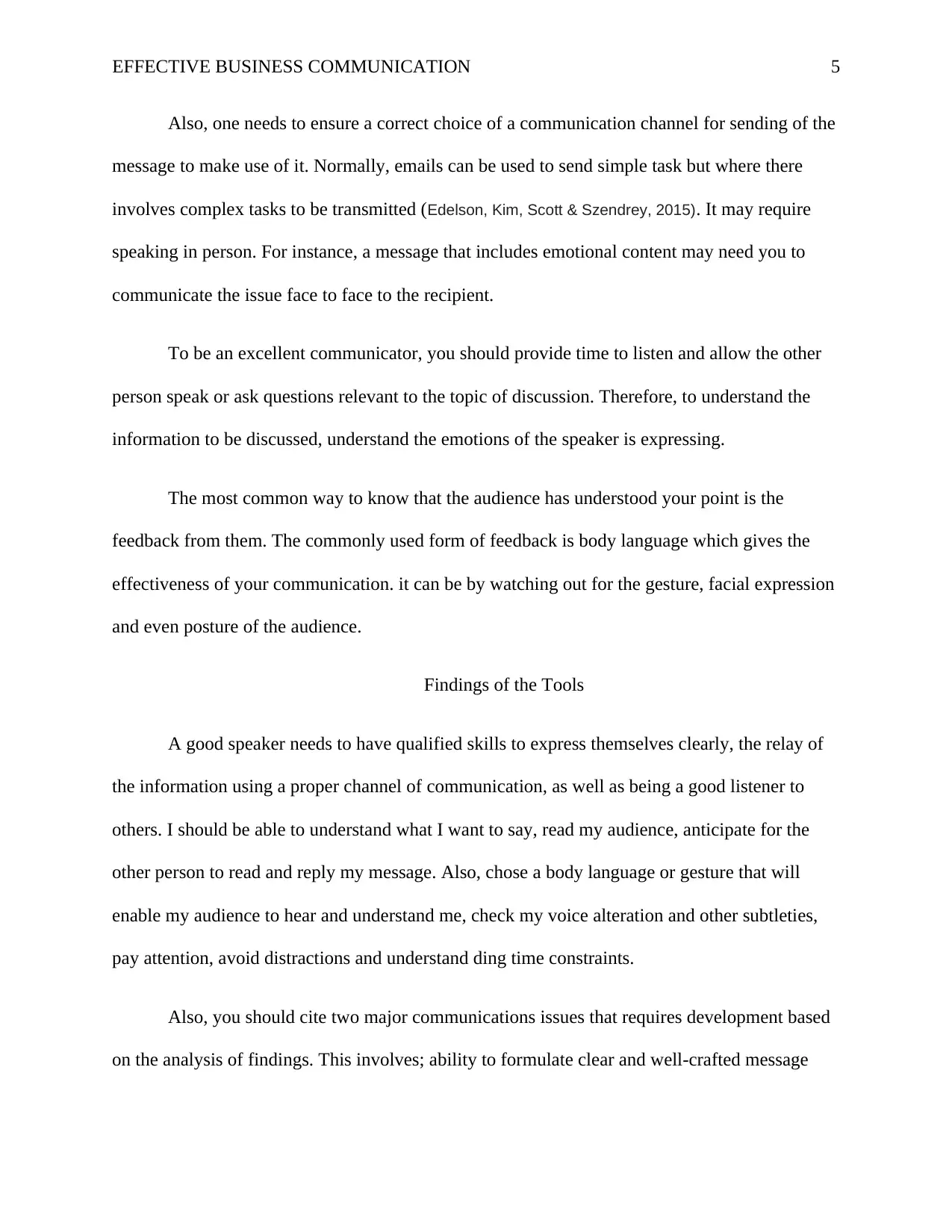
EFFECTIVE BUSINESS COMMUNICATION 5
Also, one needs to ensure a correct choice of a communication channel for sending of the
message to make use of it. Normally, emails can be used to send simple task but where there
involves complex tasks to be transmitted (Edelson, Kim, Scott & Szendrey, 2015). It may require
speaking in person. For instance, a message that includes emotional content may need you to
communicate the issue face to face to the recipient.
To be an excellent communicator, you should provide time to listen and allow the other
person speak or ask questions relevant to the topic of discussion. Therefore, to understand the
information to be discussed, understand the emotions of the speaker is expressing.
The most common way to know that the audience has understood your point is the
feedback from them. The commonly used form of feedback is body language which gives the
effectiveness of your communication. it can be by watching out for the gesture, facial expression
and even posture of the audience.
Findings of the Tools
A good speaker needs to have qualified skills to express themselves clearly, the relay of
the information using a proper channel of communication, as well as being a good listener to
others. I should be able to understand what I want to say, read my audience, anticipate for the
other person to read and reply my message. Also, chose a body language or gesture that will
enable my audience to hear and understand me, check my voice alteration and other subtleties,
pay attention, avoid distractions and understand ding time constraints.
Also, you should cite two major communications issues that requires development based
on the analysis of findings. This involves; ability to formulate clear and well-crafted message
Also, one needs to ensure a correct choice of a communication channel for sending of the
message to make use of it. Normally, emails can be used to send simple task but where there
involves complex tasks to be transmitted (Edelson, Kim, Scott & Szendrey, 2015). It may require
speaking in person. For instance, a message that includes emotional content may need you to
communicate the issue face to face to the recipient.
To be an excellent communicator, you should provide time to listen and allow the other
person speak or ask questions relevant to the topic of discussion. Therefore, to understand the
information to be discussed, understand the emotions of the speaker is expressing.
The most common way to know that the audience has understood your point is the
feedback from them. The commonly used form of feedback is body language which gives the
effectiveness of your communication. it can be by watching out for the gesture, facial expression
and even posture of the audience.
Findings of the Tools
A good speaker needs to have qualified skills to express themselves clearly, the relay of
the information using a proper channel of communication, as well as being a good listener to
others. I should be able to understand what I want to say, read my audience, anticipate for the
other person to read and reply my message. Also, chose a body language or gesture that will
enable my audience to hear and understand me, check my voice alteration and other subtleties,
pay attention, avoid distractions and understand ding time constraints.
Also, you should cite two major communications issues that requires development based
on the analysis of findings. This involves; ability to formulate clear and well-crafted message
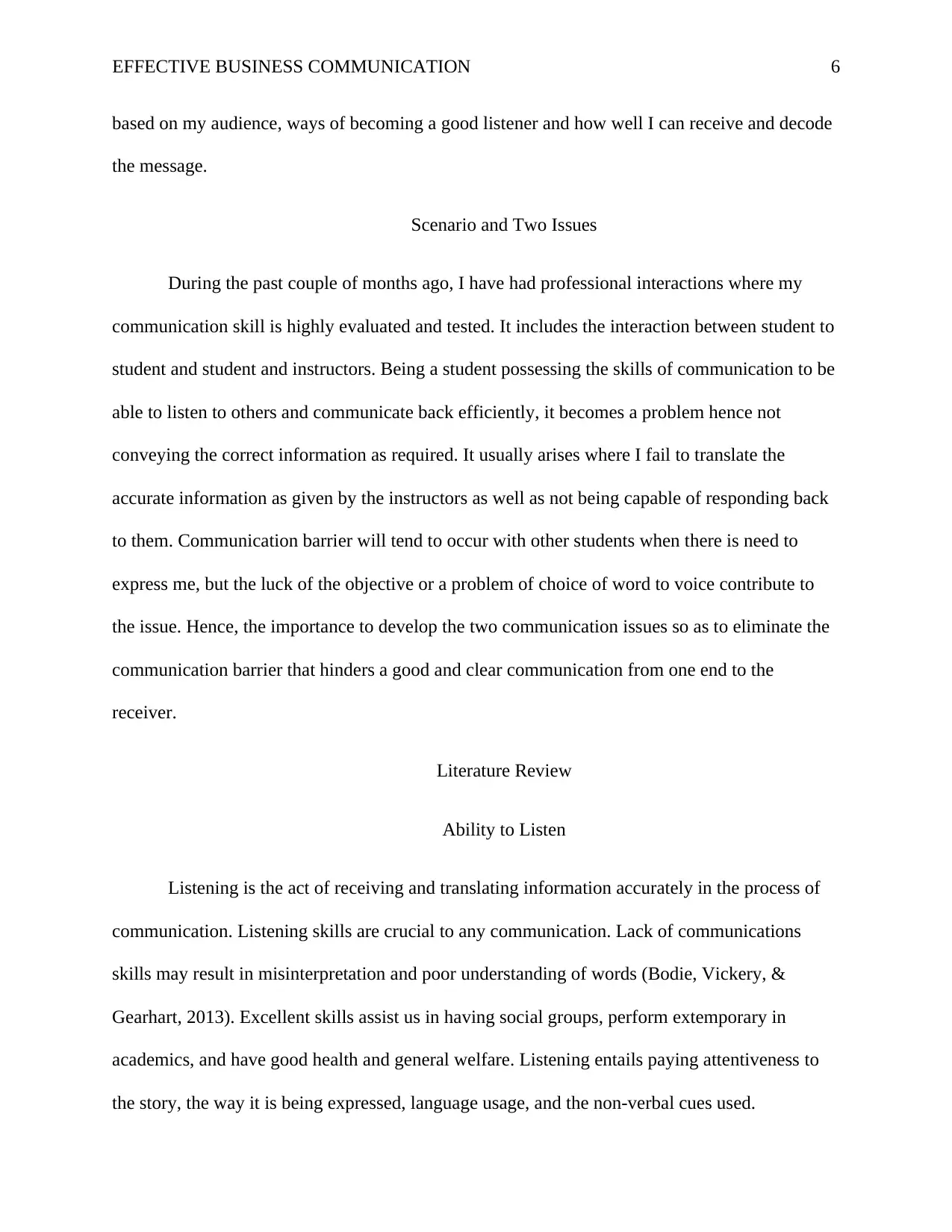
EFFECTIVE BUSINESS COMMUNICATION 6
based on my audience, ways of becoming a good listener and how well I can receive and decode
the message.
Scenario and Two Issues
During the past couple of months ago, I have had professional interactions where my
communication skill is highly evaluated and tested. It includes the interaction between student to
student and student and instructors. Being a student possessing the skills of communication to be
able to listen to others and communicate back efficiently, it becomes a problem hence not
conveying the correct information as required. It usually arises where I fail to translate the
accurate information as given by the instructors as well as not being capable of responding back
to them. Communication barrier will tend to occur with other students when there is need to
express me, but the luck of the objective or a problem of choice of word to voice contribute to
the issue. Hence, the importance to develop the two communication issues so as to eliminate the
communication barrier that hinders a good and clear communication from one end to the
receiver.
Literature Review
Ability to Listen
Listening is the act of receiving and translating information accurately in the process of
communication. Listening skills are crucial to any communication. Lack of communications
skills may result in misinterpretation and poor understanding of words (Bodie, Vickery, &
Gearhart, 2013). Excellent skills assist us in having social groups, perform extemporary in
academics, and have good health and general welfare. Listening entails paying attentiveness to
the story, the way it is being expressed, language usage, and the non-verbal cues used.
based on my audience, ways of becoming a good listener and how well I can receive and decode
the message.
Scenario and Two Issues
During the past couple of months ago, I have had professional interactions where my
communication skill is highly evaluated and tested. It includes the interaction between student to
student and student and instructors. Being a student possessing the skills of communication to be
able to listen to others and communicate back efficiently, it becomes a problem hence not
conveying the correct information as required. It usually arises where I fail to translate the
accurate information as given by the instructors as well as not being capable of responding back
to them. Communication barrier will tend to occur with other students when there is need to
express me, but the luck of the objective or a problem of choice of word to voice contribute to
the issue. Hence, the importance to develop the two communication issues so as to eliminate the
communication barrier that hinders a good and clear communication from one end to the
receiver.
Literature Review
Ability to Listen
Listening is the act of receiving and translating information accurately in the process of
communication. Listening skills are crucial to any communication. Lack of communications
skills may result in misinterpretation and poor understanding of words (Bodie, Vickery, &
Gearhart, 2013). Excellent skills assist us in having social groups, perform extemporary in
academics, and have good health and general welfare. Listening entails paying attentiveness to
the story, the way it is being expressed, language usage, and the non-verbal cues used.
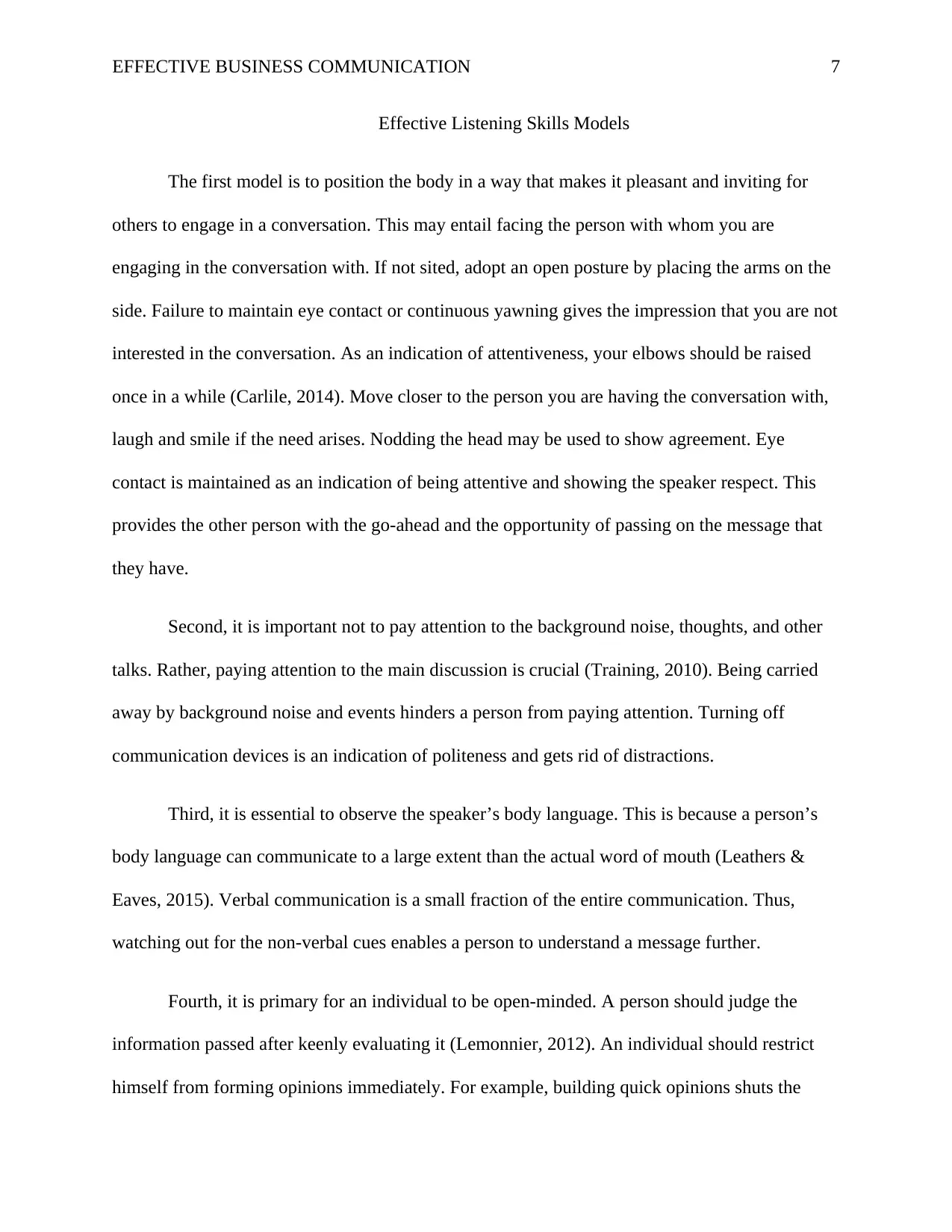
EFFECTIVE BUSINESS COMMUNICATION 7
Effective Listening Skills Models
The first model is to position the body in a way that makes it pleasant and inviting for
others to engage in a conversation. This may entail facing the person with whom you are
engaging in the conversation with. If not sited, adopt an open posture by placing the arms on the
side. Failure to maintain eye contact or continuous yawning gives the impression that you are not
interested in the conversation. As an indication of attentiveness, your elbows should be raised
once in a while (Carlile, 2014). Move closer to the person you are having the conversation with,
laugh and smile if the need arises. Nodding the head may be used to show agreement. Eye
contact is maintained as an indication of being attentive and showing the speaker respect. This
provides the other person with the go-ahead and the opportunity of passing on the message that
they have.
Second, it is important not to pay attention to the background noise, thoughts, and other
talks. Rather, paying attention to the main discussion is crucial (Training, 2010). Being carried
away by background noise and events hinders a person from paying attention. Turning off
communication devices is an indication of politeness and gets rid of distractions.
Third, it is essential to observe the speaker’s body language. This is because a person’s
body language can communicate to a large extent than the actual word of mouth (Leathers &
Eaves, 2015). Verbal communication is a small fraction of the entire communication. Thus,
watching out for the non-verbal cues enables a person to understand a message further.
Fourth, it is primary for an individual to be open-minded. A person should judge the
information passed after keenly evaluating it (Lemonnier, 2012). An individual should restrict
himself from forming opinions immediately. For example, building quick opinions shuts the
Effective Listening Skills Models
The first model is to position the body in a way that makes it pleasant and inviting for
others to engage in a conversation. This may entail facing the person with whom you are
engaging in the conversation with. If not sited, adopt an open posture by placing the arms on the
side. Failure to maintain eye contact or continuous yawning gives the impression that you are not
interested in the conversation. As an indication of attentiveness, your elbows should be raised
once in a while (Carlile, 2014). Move closer to the person you are having the conversation with,
laugh and smile if the need arises. Nodding the head may be used to show agreement. Eye
contact is maintained as an indication of being attentive and showing the speaker respect. This
provides the other person with the go-ahead and the opportunity of passing on the message that
they have.
Second, it is important not to pay attention to the background noise, thoughts, and other
talks. Rather, paying attention to the main discussion is crucial (Training, 2010). Being carried
away by background noise and events hinders a person from paying attention. Turning off
communication devices is an indication of politeness and gets rid of distractions.
Third, it is essential to observe the speaker’s body language. This is because a person’s
body language can communicate to a large extent than the actual word of mouth (Leathers &
Eaves, 2015). Verbal communication is a small fraction of the entire communication. Thus,
watching out for the non-verbal cues enables a person to understand a message further.
Fourth, it is primary for an individual to be open-minded. A person should judge the
information passed after keenly evaluating it (Lemonnier, 2012). An individual should restrict
himself from forming opinions immediately. For example, building quick opinions shuts the
Paraphrase This Document
Need a fresh take? Get an instant paraphrase of this document with our AI Paraphraser
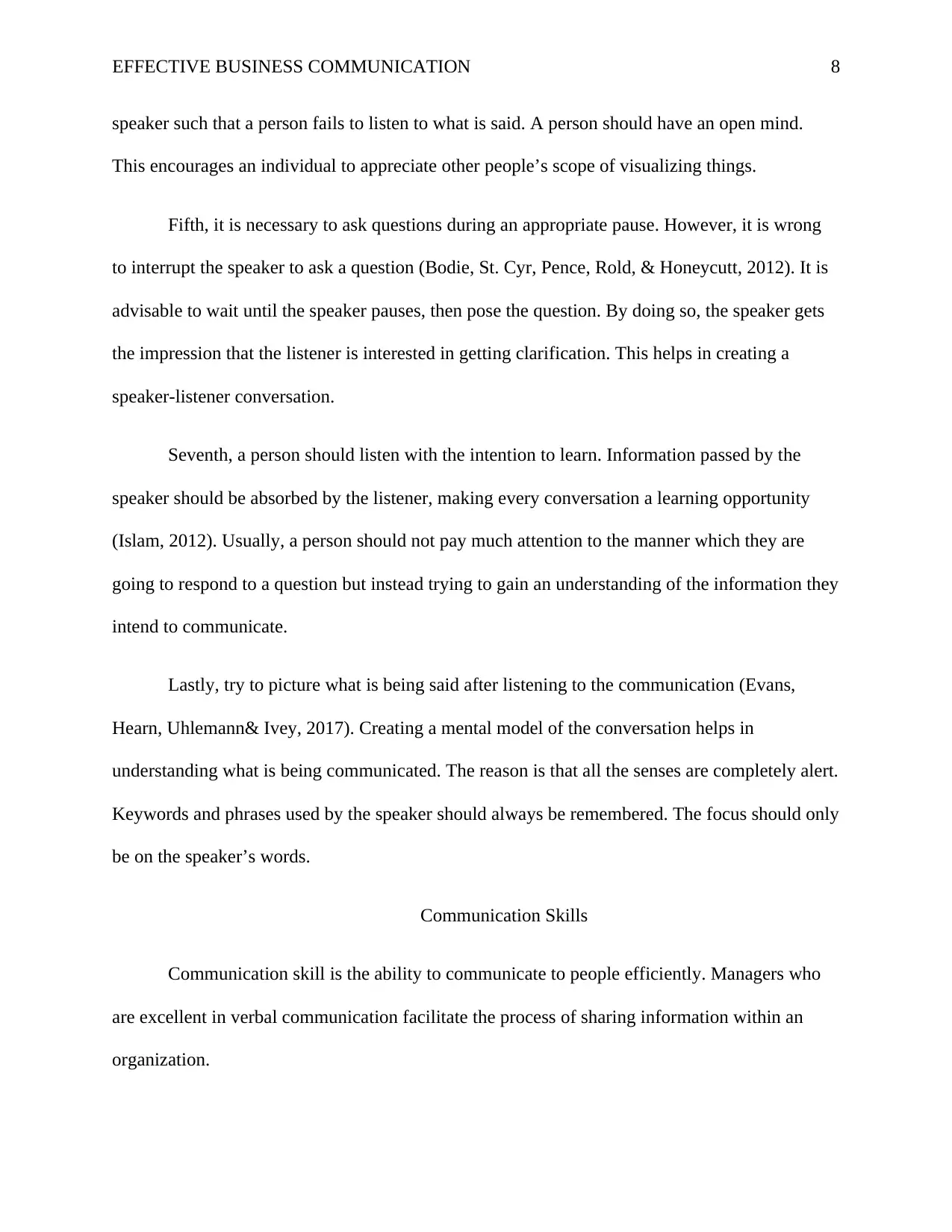
EFFECTIVE BUSINESS COMMUNICATION 8
speaker such that a person fails to listen to what is said. A person should have an open mind.
This encourages an individual to appreciate other people’s scope of visualizing things.
Fifth, it is necessary to ask questions during an appropriate pause. However, it is wrong
to interrupt the speaker to ask a question (Bodie, St. Cyr, Pence, Rold, & Honeycutt, 2012). It is
advisable to wait until the speaker pauses, then pose the question. By doing so, the speaker gets
the impression that the listener is interested in getting clarification. This helps in creating a
speaker-listener conversation.
Seventh, a person should listen with the intention to learn. Information passed by the
speaker should be absorbed by the listener, making every conversation a learning opportunity
(Islam, 2012). Usually, a person should not pay much attention to the manner which they are
going to respond to a question but instead trying to gain an understanding of the information they
intend to communicate.
Lastly, try to picture what is being said after listening to the communication (Evans,
Hearn, Uhlemann& Ivey, 2017). Creating a mental model of the conversation helps in
understanding what is being communicated. The reason is that all the senses are completely alert.
Keywords and phrases used by the speaker should always be remembered. The focus should only
be on the speaker’s words.
Communication Skills
Communication skill is the ability to communicate to people efficiently. Managers who
are excellent in verbal communication facilitate the process of sharing information within an
organization.
speaker such that a person fails to listen to what is said. A person should have an open mind.
This encourages an individual to appreciate other people’s scope of visualizing things.
Fifth, it is necessary to ask questions during an appropriate pause. However, it is wrong
to interrupt the speaker to ask a question (Bodie, St. Cyr, Pence, Rold, & Honeycutt, 2012). It is
advisable to wait until the speaker pauses, then pose the question. By doing so, the speaker gets
the impression that the listener is interested in getting clarification. This helps in creating a
speaker-listener conversation.
Seventh, a person should listen with the intention to learn. Information passed by the
speaker should be absorbed by the listener, making every conversation a learning opportunity
(Islam, 2012). Usually, a person should not pay much attention to the manner which they are
going to respond to a question but instead trying to gain an understanding of the information they
intend to communicate.
Lastly, try to picture what is being said after listening to the communication (Evans,
Hearn, Uhlemann& Ivey, 2017). Creating a mental model of the conversation helps in
understanding what is being communicated. The reason is that all the senses are completely alert.
Keywords and phrases used by the speaker should always be remembered. The focus should only
be on the speaker’s words.
Communication Skills
Communication skill is the ability to communicate to people efficiently. Managers who
are excellent in verbal communication facilitate the process of sharing information within an
organization.
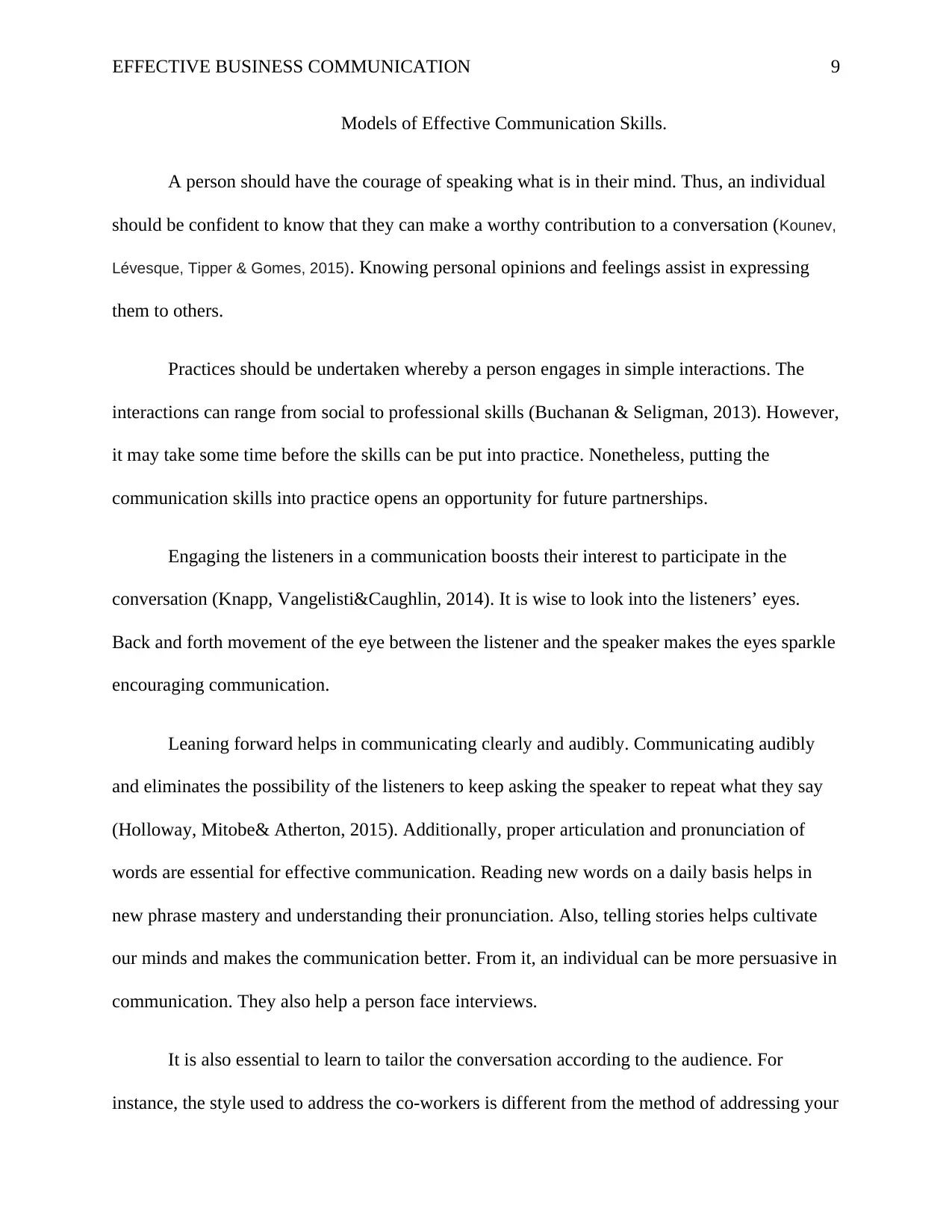
EFFECTIVE BUSINESS COMMUNICATION 9
Models of Effective Communication Skills.
A person should have the courage of speaking what is in their mind. Thus, an individual
should be confident to know that they can make a worthy contribution to a conversation (Kounev,
Lévesque, Tipper & Gomes, 2015). Knowing personal opinions and feelings assist in expressing
them to others.
Practices should be undertaken whereby a person engages in simple interactions. The
interactions can range from social to professional skills (Buchanan & Seligman, 2013). However,
it may take some time before the skills can be put into practice. Nonetheless, putting the
communication skills into practice opens an opportunity for future partnerships.
Engaging the listeners in a communication boosts their interest to participate in the
conversation (Knapp, Vangelisti&Caughlin, 2014). It is wise to look into the listeners’ eyes.
Back and forth movement of the eye between the listener and the speaker makes the eyes sparkle
encouraging communication.
Leaning forward helps in communicating clearly and audibly. Communicating audibly
and eliminates the possibility of the listeners to keep asking the speaker to repeat what they say
(Holloway, Mitobe& Atherton, 2015). Additionally, proper articulation and pronunciation of
words are essential for effective communication. Reading new words on a daily basis helps in
new phrase mastery and understanding their pronunciation. Also, telling stories helps cultivate
our minds and makes the communication better. From it, an individual can be more persuasive in
communication. They also help a person face interviews.
It is also essential to learn to tailor the conversation according to the audience. For
instance, the style used to address the co-workers is different from the method of addressing your
Models of Effective Communication Skills.
A person should have the courage of speaking what is in their mind. Thus, an individual
should be confident to know that they can make a worthy contribution to a conversation (Kounev,
Lévesque, Tipper & Gomes, 2015). Knowing personal opinions and feelings assist in expressing
them to others.
Practices should be undertaken whereby a person engages in simple interactions. The
interactions can range from social to professional skills (Buchanan & Seligman, 2013). However,
it may take some time before the skills can be put into practice. Nonetheless, putting the
communication skills into practice opens an opportunity for future partnerships.
Engaging the listeners in a communication boosts their interest to participate in the
conversation (Knapp, Vangelisti&Caughlin, 2014). It is wise to look into the listeners’ eyes.
Back and forth movement of the eye between the listener and the speaker makes the eyes sparkle
encouraging communication.
Leaning forward helps in communicating clearly and audibly. Communicating audibly
and eliminates the possibility of the listeners to keep asking the speaker to repeat what they say
(Holloway, Mitobe& Atherton, 2015). Additionally, proper articulation and pronunciation of
words are essential for effective communication. Reading new words on a daily basis helps in
new phrase mastery and understanding their pronunciation. Also, telling stories helps cultivate
our minds and makes the communication better. From it, an individual can be more persuasive in
communication. They also help a person face interviews.
It is also essential to learn to tailor the conversation according to the audience. For
instance, the style used to address the co-workers is different from the method of addressing your
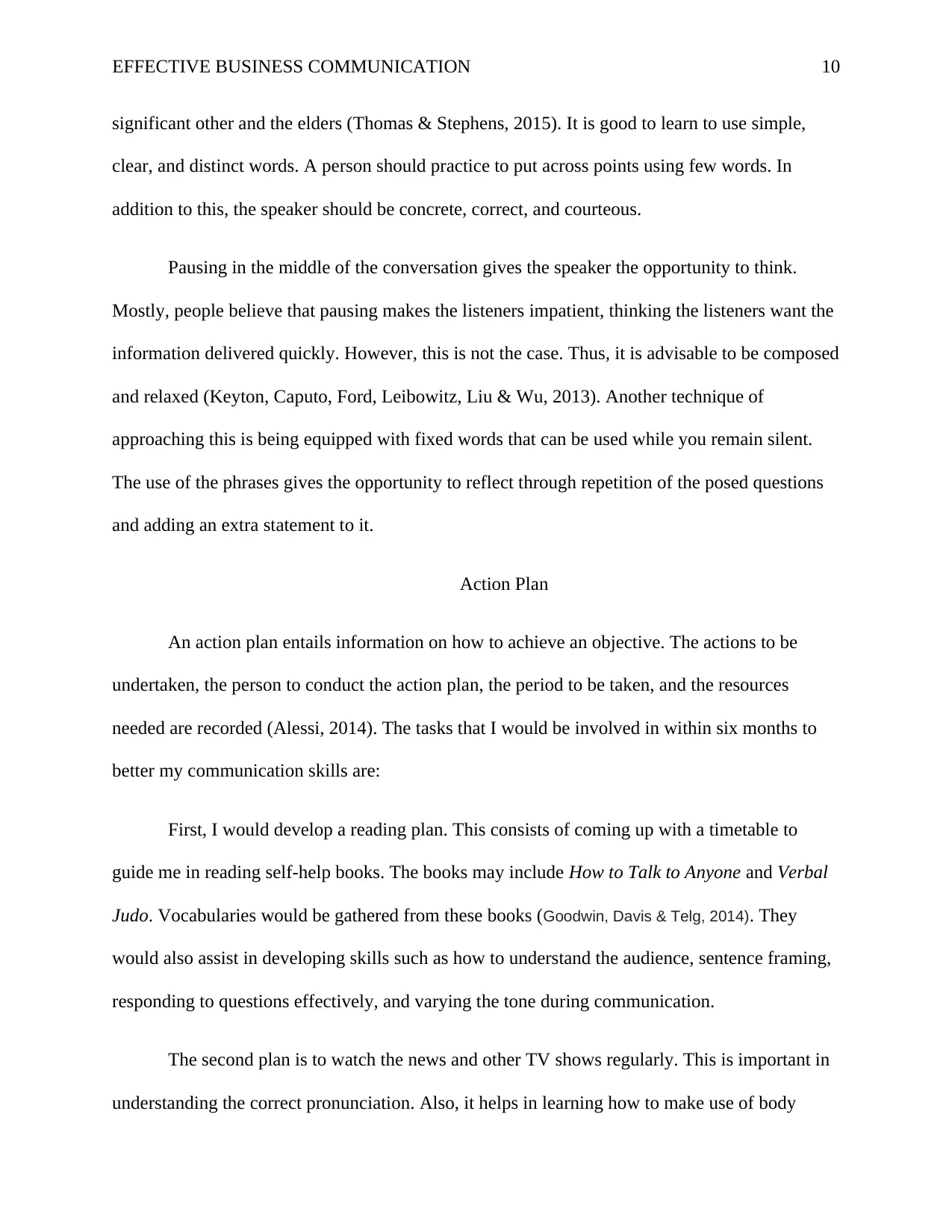
EFFECTIVE BUSINESS COMMUNICATION 10
significant other and the elders (Thomas & Stephens, 2015). It is good to learn to use simple,
clear, and distinct words. A person should practice to put across points using few words. In
addition to this, the speaker should be concrete, correct, and courteous.
Pausing in the middle of the conversation gives the speaker the opportunity to think.
Mostly, people believe that pausing makes the listeners impatient, thinking the listeners want the
information delivered quickly. However, this is not the case. Thus, it is advisable to be composed
and relaxed (Keyton, Caputo, Ford, Leibowitz, Liu & Wu, 2013). Another technique of
approaching this is being equipped with fixed words that can be used while you remain silent.
The use of the phrases gives the opportunity to reflect through repetition of the posed questions
and adding an extra statement to it.
Action Plan
An action plan entails information on how to achieve an objective. The actions to be
undertaken, the person to conduct the action plan, the period to be taken, and the resources
needed are recorded (Alessi, 2014). The tasks that I would be involved in within six months to
better my communication skills are:
First, I would develop a reading plan. This consists of coming up with a timetable to
guide me in reading self-help books. The books may include How to Talk to Anyone and Verbal
Judo. Vocabularies would be gathered from these books (Goodwin, Davis & Telg, 2014). They
would also assist in developing skills such as how to understand the audience, sentence framing,
responding to questions effectively, and varying the tone during communication.
The second plan is to watch the news and other TV shows regularly. This is important in
understanding the correct pronunciation. Also, it helps in learning how to make use of body
significant other and the elders (Thomas & Stephens, 2015). It is good to learn to use simple,
clear, and distinct words. A person should practice to put across points using few words. In
addition to this, the speaker should be concrete, correct, and courteous.
Pausing in the middle of the conversation gives the speaker the opportunity to think.
Mostly, people believe that pausing makes the listeners impatient, thinking the listeners want the
information delivered quickly. However, this is not the case. Thus, it is advisable to be composed
and relaxed (Keyton, Caputo, Ford, Leibowitz, Liu & Wu, 2013). Another technique of
approaching this is being equipped with fixed words that can be used while you remain silent.
The use of the phrases gives the opportunity to reflect through repetition of the posed questions
and adding an extra statement to it.
Action Plan
An action plan entails information on how to achieve an objective. The actions to be
undertaken, the person to conduct the action plan, the period to be taken, and the resources
needed are recorded (Alessi, 2014). The tasks that I would be involved in within six months to
better my communication skills are:
First, I would develop a reading plan. This consists of coming up with a timetable to
guide me in reading self-help books. The books may include How to Talk to Anyone and Verbal
Judo. Vocabularies would be gathered from these books (Goodwin, Davis & Telg, 2014). They
would also assist in developing skills such as how to understand the audience, sentence framing,
responding to questions effectively, and varying the tone during communication.
The second plan is to watch the news and other TV shows regularly. This is important in
understanding the correct pronunciation. Also, it helps in learning how to make use of body
Secure Best Marks with AI Grader
Need help grading? Try our AI Grader for instant feedback on your assignments.
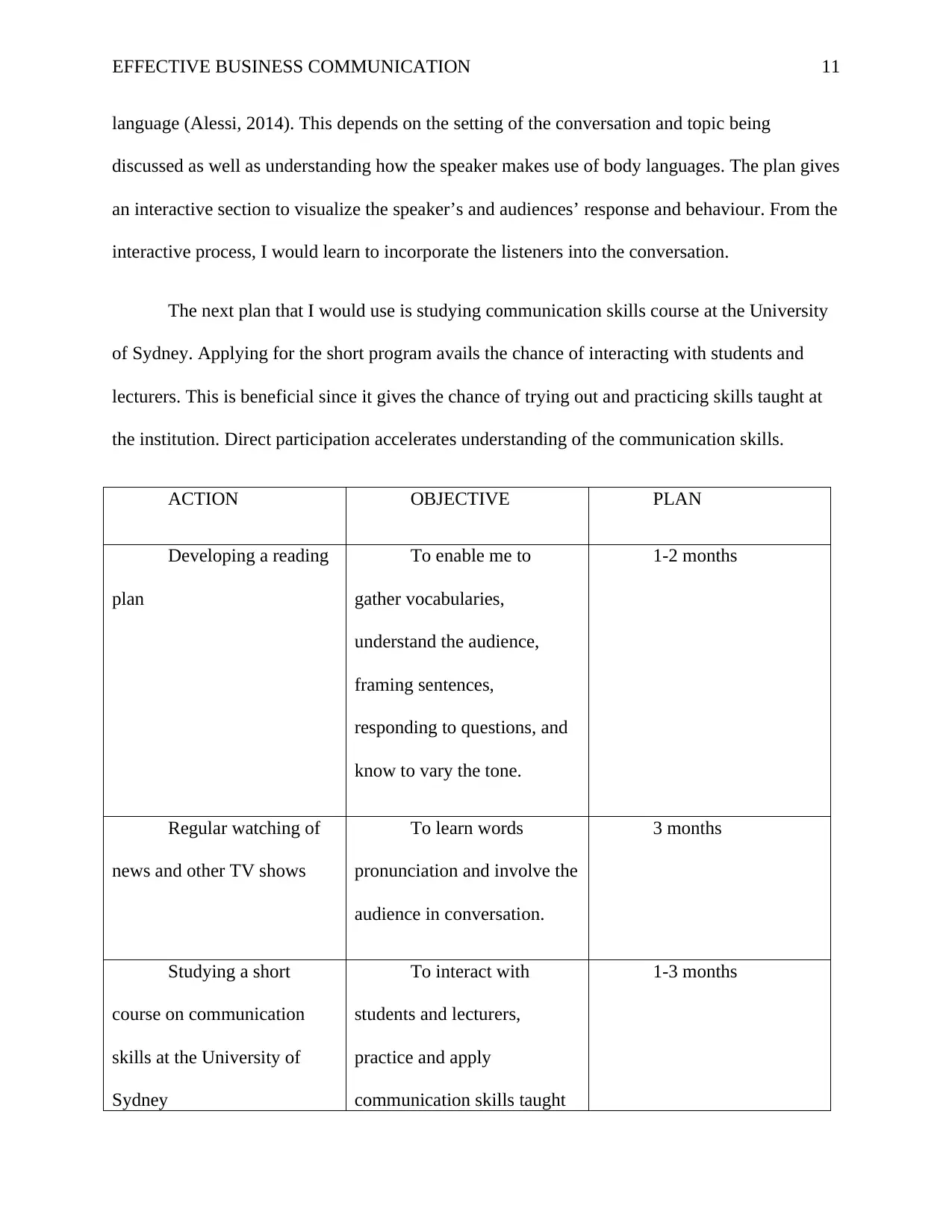
EFFECTIVE BUSINESS COMMUNICATION 11
language (Alessi, 2014). This depends on the setting of the conversation and topic being
discussed as well as understanding how the speaker makes use of body languages. The plan gives
an interactive section to visualize the speaker’s and audiences’ response and behaviour. From the
interactive process, I would learn to incorporate the listeners into the conversation.
The next plan that I would use is studying communication skills course at the University
of Sydney. Applying for the short program avails the chance of interacting with students and
lecturers. This is beneficial since it gives the chance of trying out and practicing skills taught at
the institution. Direct participation accelerates understanding of the communication skills.
ACTION OBJECTIVE PLAN
Developing a reading
plan
To enable me to
gather vocabularies,
understand the audience,
framing sentences,
responding to questions, and
know to vary the tone.
1-2 months
Regular watching of
news and other TV shows
To learn words
pronunciation and involve the
audience in conversation.
3 months
Studying a short
course on communication
skills at the University of
Sydney
To interact with
students and lecturers,
practice and apply
communication skills taught
1-3 months
language (Alessi, 2014). This depends on the setting of the conversation and topic being
discussed as well as understanding how the speaker makes use of body languages. The plan gives
an interactive section to visualize the speaker’s and audiences’ response and behaviour. From the
interactive process, I would learn to incorporate the listeners into the conversation.
The next plan that I would use is studying communication skills course at the University
of Sydney. Applying for the short program avails the chance of interacting with students and
lecturers. This is beneficial since it gives the chance of trying out and practicing skills taught at
the institution. Direct participation accelerates understanding of the communication skills.
ACTION OBJECTIVE PLAN
Developing a reading
plan
To enable me to
gather vocabularies,
understand the audience,
framing sentences,
responding to questions, and
know to vary the tone.
1-2 months
Regular watching of
news and other TV shows
To learn words
pronunciation and involve the
audience in conversation.
3 months
Studying a short
course on communication
skills at the University of
Sydney
To interact with
students and lecturers,
practice and apply
communication skills taught
1-3 months
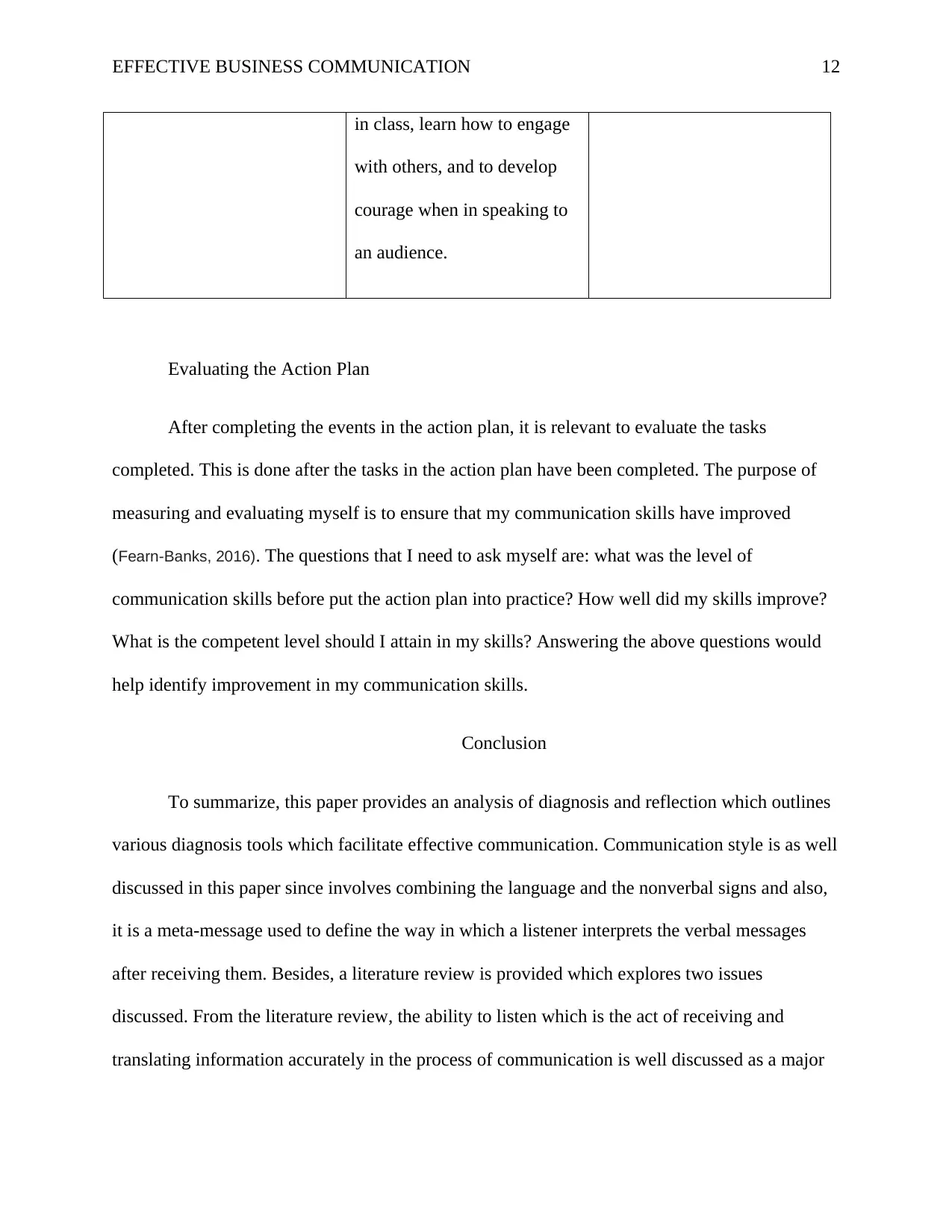
EFFECTIVE BUSINESS COMMUNICATION 12
in class, learn how to engage
with others, and to develop
courage when in speaking to
an audience.
Evaluating the Action Plan
After completing the events in the action plan, it is relevant to evaluate the tasks
completed. This is done after the tasks in the action plan have been completed. The purpose of
measuring and evaluating myself is to ensure that my communication skills have improved
(Fearn-Banks, 2016). The questions that I need to ask myself are: what was the level of
communication skills before put the action plan into practice? How well did my skills improve?
What is the competent level should I attain in my skills? Answering the above questions would
help identify improvement in my communication skills.
Conclusion
To summarize, this paper provides an analysis of diagnosis and reflection which outlines
various diagnosis tools which facilitate effective communication. Communication style is as well
discussed in this paper since involves combining the language and the nonverbal signs and also,
it is a meta-message used to define the way in which a listener interprets the verbal messages
after receiving them. Besides, a literature review is provided which explores two issues
discussed. From the literature review, the ability to listen which is the act of receiving and
translating information accurately in the process of communication is well discussed as a major
in class, learn how to engage
with others, and to develop
courage when in speaking to
an audience.
Evaluating the Action Plan
After completing the events in the action plan, it is relevant to evaluate the tasks
completed. This is done after the tasks in the action plan have been completed. The purpose of
measuring and evaluating myself is to ensure that my communication skills have improved
(Fearn-Banks, 2016). The questions that I need to ask myself are: what was the level of
communication skills before put the action plan into practice? How well did my skills improve?
What is the competent level should I attain in my skills? Answering the above questions would
help identify improvement in my communication skills.
Conclusion
To summarize, this paper provides an analysis of diagnosis and reflection which outlines
various diagnosis tools which facilitate effective communication. Communication style is as well
discussed in this paper since involves combining the language and the nonverbal signs and also,
it is a meta-message used to define the way in which a listener interprets the verbal messages
after receiving them. Besides, a literature review is provided which explores two issues
discussed. From the literature review, the ability to listen which is the act of receiving and
translating information accurately in the process of communication is well discussed as a major
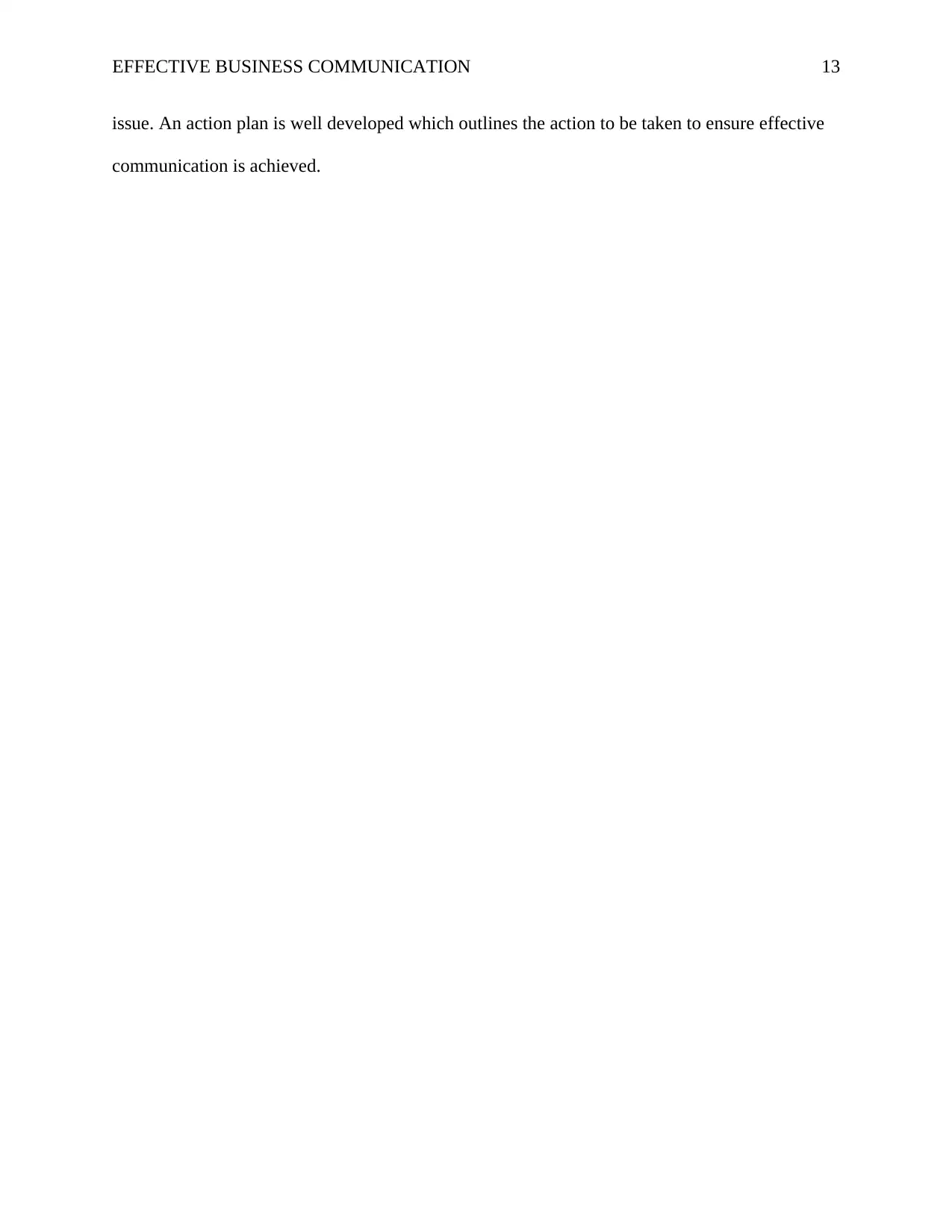
EFFECTIVE BUSINESS COMMUNICATION 13
issue. An action plan is well developed which outlines the action to be taken to ensure effective
communication is achieved.
issue. An action plan is well developed which outlines the action to be taken to ensure effective
communication is achieved.
Paraphrase This Document
Need a fresh take? Get an instant paraphrase of this document with our AI Paraphraser
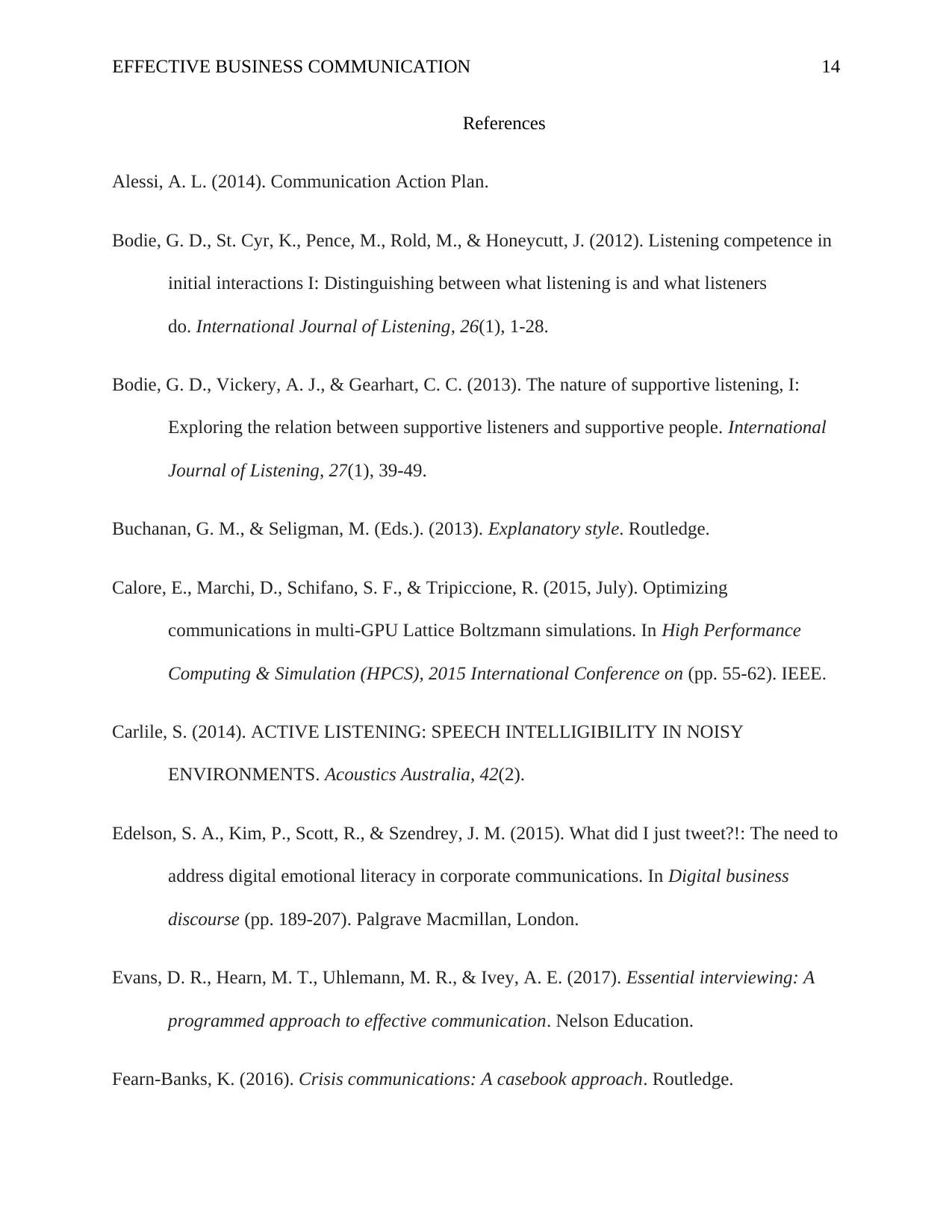
EFFECTIVE BUSINESS COMMUNICATION 14
References
Alessi, A. L. (2014). Communication Action Plan.
Bodie, G. D., St. Cyr, K., Pence, M., Rold, M., & Honeycutt, J. (2012). Listening competence in
initial interactions I: Distinguishing between what listening is and what listeners
do. International Journal of Listening, 26(1), 1-28.
Bodie, G. D., Vickery, A. J., & Gearhart, C. C. (2013). The nature of supportive listening, I:
Exploring the relation between supportive listeners and supportive people. International
Journal of Listening, 27(1), 39-49.
Buchanan, G. M., & Seligman, M. (Eds.). (2013). Explanatory style. Routledge.
Calore, E., Marchi, D., Schifano, S. F., & Tripiccione, R. (2015, July). Optimizing
communications in multi-GPU Lattice Boltzmann simulations. In High Performance
Computing & Simulation (HPCS), 2015 International Conference on (pp. 55-62). IEEE.
Carlile, S. (2014). ACTIVE LISTENING: SPEECH INTELLIGIBILITY IN NOISY
ENVIRONMENTS. Acoustics Australia, 42(2).
Edelson, S. A., Kim, P., Scott, R., & Szendrey, J. M. (2015). What did I just tweet?!: The need to
address digital emotional literacy in corporate communications. In Digital business
discourse (pp. 189-207). Palgrave Macmillan, London.
Evans, D. R., Hearn, M. T., Uhlemann, M. R., & Ivey, A. E. (2017). Essential interviewing: A
programmed approach to effective communication. Nelson Education.
Fearn-Banks, K. (2016). Crisis communications: A casebook approach. Routledge.
References
Alessi, A. L. (2014). Communication Action Plan.
Bodie, G. D., St. Cyr, K., Pence, M., Rold, M., & Honeycutt, J. (2012). Listening competence in
initial interactions I: Distinguishing between what listening is and what listeners
do. International Journal of Listening, 26(1), 1-28.
Bodie, G. D., Vickery, A. J., & Gearhart, C. C. (2013). The nature of supportive listening, I:
Exploring the relation between supportive listeners and supportive people. International
Journal of Listening, 27(1), 39-49.
Buchanan, G. M., & Seligman, M. (Eds.). (2013). Explanatory style. Routledge.
Calore, E., Marchi, D., Schifano, S. F., & Tripiccione, R. (2015, July). Optimizing
communications in multi-GPU Lattice Boltzmann simulations. In High Performance
Computing & Simulation (HPCS), 2015 International Conference on (pp. 55-62). IEEE.
Carlile, S. (2014). ACTIVE LISTENING: SPEECH INTELLIGIBILITY IN NOISY
ENVIRONMENTS. Acoustics Australia, 42(2).
Edelson, S. A., Kim, P., Scott, R., & Szendrey, J. M. (2015). What did I just tweet?!: The need to
address digital emotional literacy in corporate communications. In Digital business
discourse (pp. 189-207). Palgrave Macmillan, London.
Evans, D. R., Hearn, M. T., Uhlemann, M. R., & Ivey, A. E. (2017). Essential interviewing: A
programmed approach to effective communication. Nelson Education.
Fearn-Banks, K. (2016). Crisis communications: A casebook approach. Routledge.
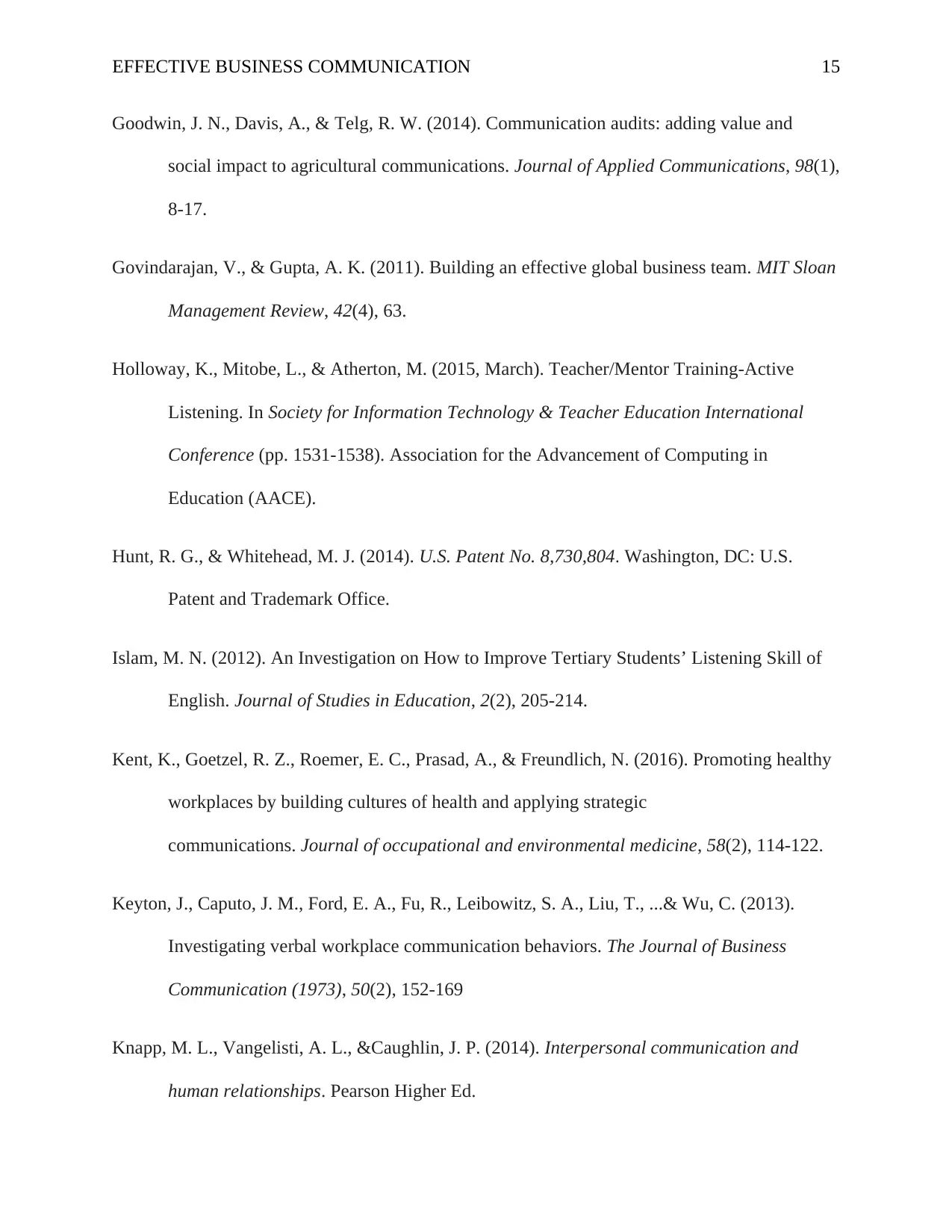
EFFECTIVE BUSINESS COMMUNICATION 15
Goodwin, J. N., Davis, A., & Telg, R. W. (2014). Communication audits: adding value and
social impact to agricultural communications. Journal of Applied Communications, 98(1),
8-17.
Govindarajan, V., & Gupta, A. K. (2011). Building an effective global business team. MIT Sloan
Management Review, 42(4), 63.
Holloway, K., Mitobe, L., & Atherton, M. (2015, March). Teacher/Mentor Training-Active
Listening. In Society for Information Technology & Teacher Education International
Conference (pp. 1531-1538). Association for the Advancement of Computing in
Education (AACE).
Hunt, R. G., & Whitehead, M. J. (2014). U.S. Patent No. 8,730,804. Washington, DC: U.S.
Patent and Trademark Office.
Islam, M. N. (2012). An Investigation on How to Improve Tertiary Students’ Listening Skill of
English. Journal of Studies in Education, 2(2), 205-214.
Kent, K., Goetzel, R. Z., Roemer, E. C., Prasad, A., & Freundlich, N. (2016). Promoting healthy
workplaces by building cultures of health and applying strategic
communications. Journal of occupational and environmental medicine, 58(2), 114-122.
Keyton, J., Caputo, J. M., Ford, E. A., Fu, R., Leibowitz, S. A., Liu, T., ...& Wu, C. (2013).
Investigating verbal workplace communication behaviors. The Journal of Business
Communication (1973), 50(2), 152-169
Knapp, M. L., Vangelisti, A. L., &Caughlin, J. P. (2014). Interpersonal communication and
human relationships. Pearson Higher Ed.
Goodwin, J. N., Davis, A., & Telg, R. W. (2014). Communication audits: adding value and
social impact to agricultural communications. Journal of Applied Communications, 98(1),
8-17.
Govindarajan, V., & Gupta, A. K. (2011). Building an effective global business team. MIT Sloan
Management Review, 42(4), 63.
Holloway, K., Mitobe, L., & Atherton, M. (2015, March). Teacher/Mentor Training-Active
Listening. In Society for Information Technology & Teacher Education International
Conference (pp. 1531-1538). Association for the Advancement of Computing in
Education (AACE).
Hunt, R. G., & Whitehead, M. J. (2014). U.S. Patent No. 8,730,804. Washington, DC: U.S.
Patent and Trademark Office.
Islam, M. N. (2012). An Investigation on How to Improve Tertiary Students’ Listening Skill of
English. Journal of Studies in Education, 2(2), 205-214.
Kent, K., Goetzel, R. Z., Roemer, E. C., Prasad, A., & Freundlich, N. (2016). Promoting healthy
workplaces by building cultures of health and applying strategic
communications. Journal of occupational and environmental medicine, 58(2), 114-122.
Keyton, J., Caputo, J. M., Ford, E. A., Fu, R., Leibowitz, S. A., Liu, T., ...& Wu, C. (2013).
Investigating verbal workplace communication behaviors. The Journal of Business
Communication (1973), 50(2), 152-169
Knapp, M. L., Vangelisti, A. L., &Caughlin, J. P. (2014). Interpersonal communication and
human relationships. Pearson Higher Ed.
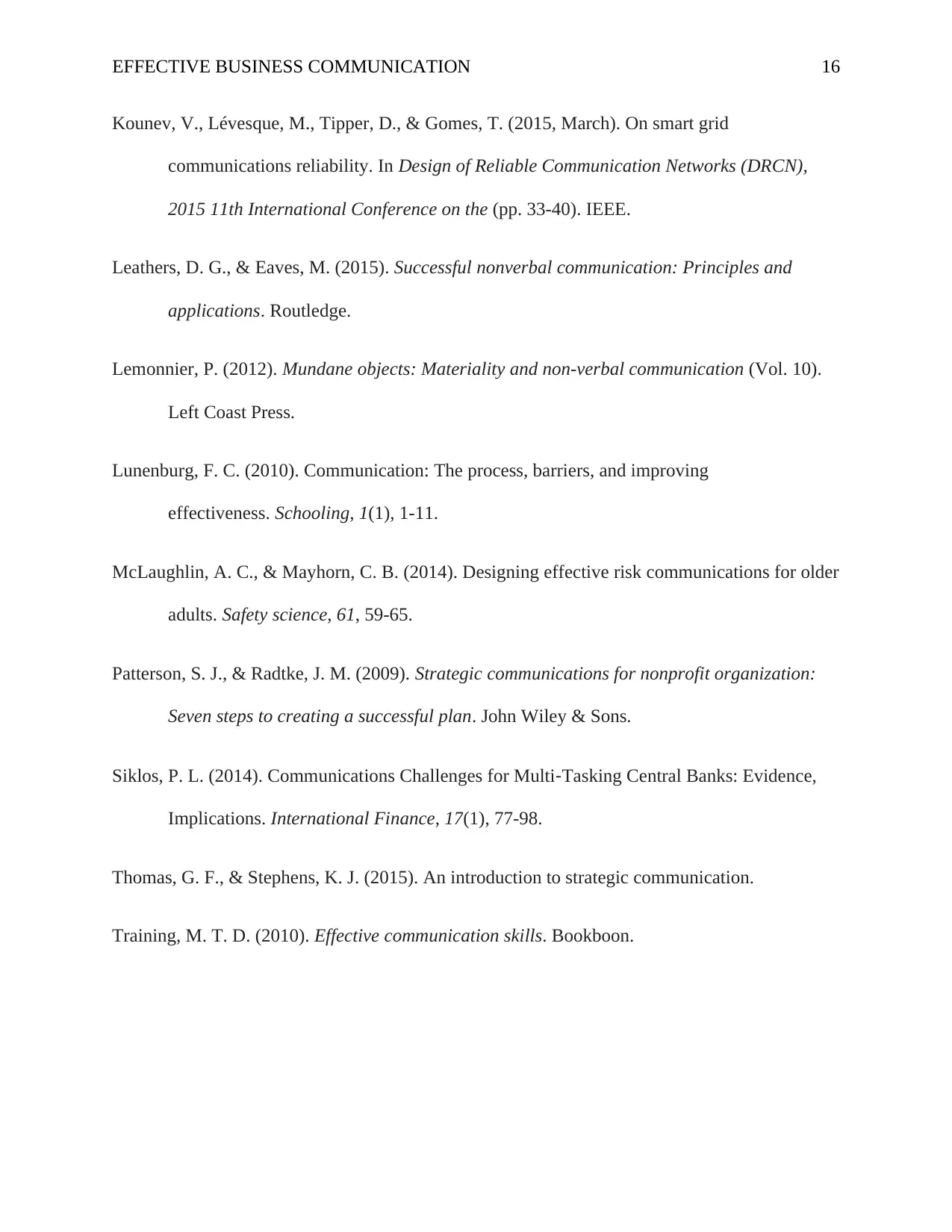
EFFECTIVE BUSINESS COMMUNICATION 16
Kounev, V., Lévesque, M., Tipper, D., & Gomes, T. (2015, March). On smart grid
communications reliability. In Design of Reliable Communication Networks (DRCN),
2015 11th International Conference on the (pp. 33-40). IEEE.
Leathers, D. G., & Eaves, M. (2015). Successful nonverbal communication: Principles and
applications. Routledge.
Lemonnier, P. (2012). Mundane objects: Materiality and non-verbal communication (Vol. 10).
Left Coast Press.
Lunenburg, F. C. (2010). Communication: The process, barriers, and improving
effectiveness. Schooling, 1(1), 1-11.
McLaughlin, A. C., & Mayhorn, C. B. (2014). Designing effective risk communications for older
adults. Safety science, 61, 59-65.
Patterson, S. J., & Radtke, J. M. (2009). Strategic communications for nonprofit organization:
Seven steps to creating a successful plan. John Wiley & Sons.
Siklos, P. L. (2014). Communications Challenges for Multi‐Tasking Central Banks: Evidence,
Implications. International Finance, 17(1), 77-98.
Thomas, G. F., & Stephens, K. J. (2015). An introduction to strategic communication.
Training, M. T. D. (2010). Effective communication skills. Bookboon.
Kounev, V., Lévesque, M., Tipper, D., & Gomes, T. (2015, March). On smart grid
communications reliability. In Design of Reliable Communication Networks (DRCN),
2015 11th International Conference on the (pp. 33-40). IEEE.
Leathers, D. G., & Eaves, M. (2015). Successful nonverbal communication: Principles and
applications. Routledge.
Lemonnier, P. (2012). Mundane objects: Materiality and non-verbal communication (Vol. 10).
Left Coast Press.
Lunenburg, F. C. (2010). Communication: The process, barriers, and improving
effectiveness. Schooling, 1(1), 1-11.
McLaughlin, A. C., & Mayhorn, C. B. (2014). Designing effective risk communications for older
adults. Safety science, 61, 59-65.
Patterson, S. J., & Radtke, J. M. (2009). Strategic communications for nonprofit organization:
Seven steps to creating a successful plan. John Wiley & Sons.
Siklos, P. L. (2014). Communications Challenges for Multi‐Tasking Central Banks: Evidence,
Implications. International Finance, 17(1), 77-98.
Thomas, G. F., & Stephens, K. J. (2015). An introduction to strategic communication.
Training, M. T. D. (2010). Effective communication skills. Bookboon.
1 out of 16
Related Documents
Your All-in-One AI-Powered Toolkit for Academic Success.
+13062052269
info@desklib.com
Available 24*7 on WhatsApp / Email
![[object Object]](/_next/static/media/star-bottom.7253800d.svg)
Unlock your academic potential
© 2024 | Zucol Services PVT LTD | All rights reserved.



